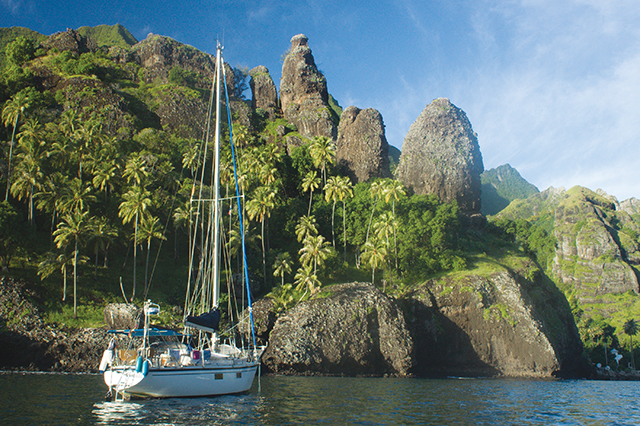The many highlights of this magical cruising ground are hard to ignore (published January 2014)

Isolated, wild and brooding with bold mountain landscapes jutting up above a vast, rippling sea, the Marquesas are magnificent. The islands have attracted many an escapee from western “civilization” over the centuries—including us modern-day sailors willing to cross a seemingly infinite ocean on little, frail boats with small, all-too-human crews. Many of us are pulled as much as pushed, lured by a siren song composed by those who came before us. But it’s hard to know what is legend and what is reality among these storied islands. So where to begin?
As Thor Heyerdahl wrote, “A painter is better armed to convey the majesty of the Marquesas than a writer.” The islands are long-extinct volcanoes that rise high above the ocean floor, their slopes deeply chiseled by the elements. It’s a wild, unique and enticing landscape like nowhere else on earth.
Each island has its own special character and highlights. The islands fall into two clusters: a southeastern (windward) group consisting of Hiva Oa, Fatu Hiva and Tahuata. Seventy miles to the northwest lay a leeward cluster made up of Nuku Hiva, Ua Pou and Ua Huka. Given the absence of fringing reefs, the Marquesas are by no means a sheltered archipelago; passages between islands are exposed.
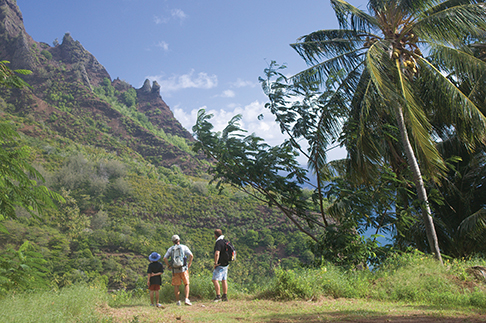
GREAT ANCHORAGES
Fatu Hiva’s Bay of Virgins (number 1 on the accompanying map) is one of the most visually dramatic anchorages in the world, where sheer cliffs and eerie rock formations plunge from thousand-foot heights into the sea. The last hours of daylight make for a mesmerizing light show every evening, as the rugged features molt to ever-deepening shades of gold. The bay is not much more than a narrow cleft in the coastline and it is relatively deep at 30 feet or more. Being on the lee side of the island, it’s usually quite calm—except for gusts that sweep down the steep slopes. There’s a free, fresh water tap right on the shore where you can fill up with refreshing and safe drinking water. The tiny settlement of Hanavave is a very welcoming place where locals offer home-cooked dinners and wooden carvings without resorting to a hard sell. Beware that Fatu Hiva is not a formal port of entry. Technically, cruisers who make a stop here without clearing in at nearby Hiva Oa can be subject to hefty fines.
Tahuata’s Hanamoenoa Bay (2) is another favorite anchorage located just around the corner from Hiva Oa’s tightly packed Tahauku Bay (near the town of Atuona). We nicknamed Hanamoenoa “Manta Bay,” a place where a perfect sandy crescent fronts a quiet anchorage with depths of 10 to 20 feet. A sandy beach is a rarity in this archipelago otherwise typified by rugged, boulder-strewn coastlines. Wild horses graze on the green slopes in this uninhabited corner of the island, and the resident manta rays are another prime attraction.
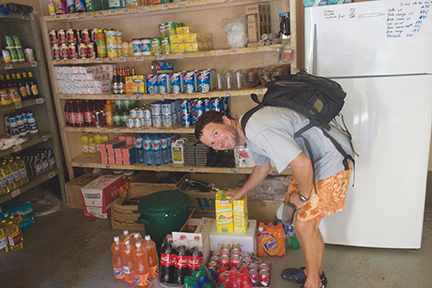
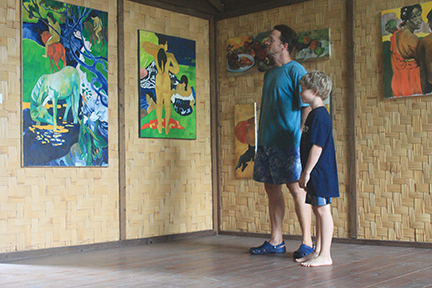
While there’s no such thing as an ugly bay in the Marquesas, Taioa Bay (also known as Daniel’s Bay, map number 3) on the southwest corner of Nuku Hiva is the only anchorage that can really hold a candle to Fatu Hiva’s Bay of Virgins. There, mountain slopes descend to the sea in echoing folds, each catching and scattering light at different angles. This is one of the better-protected anchorages in the archipelago; when you approach from the sea, it’s hard to believe there’s a bay tucked behind the jutting headland. There is a potable fresh water tap at the head of the bay where a number of gardens, but no permanent population, is located. Anchorage depth is 20 to 25 feet.
Anaho Bay (4) on the northeast coast of Nuku Hiva is unique as the only reef-lined anchorage in the Marquesas. It’s just far enough off the usual track that few boats make the trip out here, but it’s hugely rewarding for the isolated beauty of the place. Anaho Bay might just be your best chance to escape the cruising crowds while anchoring in a secure place with a scenic sandy beach. Anchorage depths are 25 to 30 feet.
GREAT HIKES
After 28 days at sea, we worried that our legs might not be up to exploring the Marquesas afoot. As Jack London wrote, “Two months at sea, barefooted all the time, without space in which to exercise one’s limbs, is not the best preliminary to leather shoes and walking.” We made do with light sandals and found that the stunning scenery always kept us inspired.
A perfect introductory hike is the short 30 to 45 minute one-way walk to the waterfall behind the village of Hanavave on Fatu Hiva (1). It’s a gorgeous, sunny spot where you can swim beneath the tall, refreshingly cool waterfall. One of the sensory highlights of the Marquesas is resting on the rocks of the creek, catching a different water tune each time you shift with the shade: the constant hum of the cascade, the high-pitched babble of water between closely spaced rocks, or the low gurgle of the flow between broader gaps amid large boulders.
Once you’ve warmed up with the walk to the waterfall, how about a 10-mile hike from Hanavave to Omoa? The rough jeep-track trail offers incredible views to the island interior and the sea. “Nature on the seventh day,” as Thor Heyerdahl put it. In Omoa, visit the petroglyphs, buy a cold drink, or send a greetings-from-paradise postcard from the small post office. To make this a one-way hike, ask Marc or another boat owner in Hanavave about the going rate for the 15-minute motorboat “shuttle” back.
Ua Pou has several hiking trails, long and short, that lead to close-up views of the stunning pinnacles in the island’s central massif. A great one-hour walk that offers a little of everything runs from the rolly anchorage in Hakahetau (5), past the interesting Tetahuna archaeological site with village ruins explained through interpretive panels, and on to a stunning, if chilly, waterfall tucked into the mountain slopes. The wet, shady spot is also favored by mosquitoes, but you can hide from them behind the curtain of the waterfall. There, the roar and sting of the water is another delight for the senses.
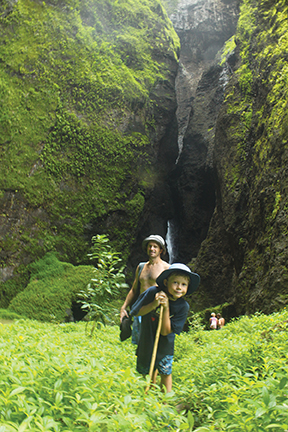
Nuku Hiva offers two not-to-be-missed hikes. One explores Herman Melville‘s lush valley described in his book Typee. Anchor in Comptrolleur Bay at the southeast end of the island and ask directions to the Paeke cult site from Taipivai village (6). It’s a pleasant 60-minute round-trip excursion that leads to interesting shrines with smiling tikis. The queen of the cascades in the Marquesas is Vaipo, a sheer 800-meter drop reachable by a two-hour hike from Taioa (Daniel’s) Bay, on the southwest end of Nuku Hiva (3). The first section of the walk winds through a lush, golden valley that can only be described as a Garden of Eden.
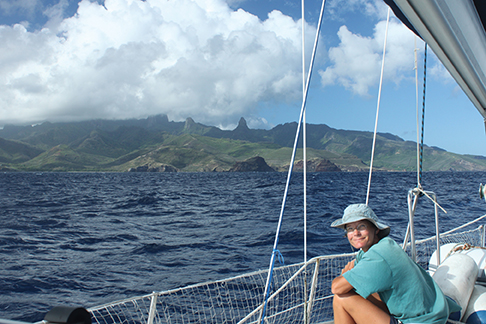
GREAT SIGHTS
Many cultural traditions ground to a halt in the dark years following contact with the first Europeans whose diseases decimated the local population. The population of Hiva Oa alone fell from an estimated tens of thousands to a mere 2,000 today. Therefore, cult sites such as the Iipona archaeological site near the village of Puamau on Hiva Oa (7) remain cloaked in mystery, even to locals. But there is no mistaking the spiritual aura of this vine-clad glen where huge statues perch proudly on massive stone pedestals. If there’s one archaeological site to visit in the Marquesas, this is it. You can brave the rolly north coast anchorage or hire a driver in Atuona for an all-day island tour. One well-known local tour driver is Marie-Jo. Bouncing along the hairpin curves of the coastal road in the back of her pickup with a hibiscus flower tucked behind your ear is an adventure in itself.
Paul Gauguin ran restlessly around the globe until he found this verdant speck of land far, far away from his native France. A small museum at the site of his atelier in Atuona on Hiva Oa is well worth a visit (8). You won’t find original works of art here, only copies, but you will see them within the context that inspired the artist to create some of his best-known paintings. Gauguin’s grave in the hillside cemetery above town has become something of a pilgrimage site as well.
Ua Pou’s skyline is unique even among islands known for their dramatic profiles, with vertical rock pinnacles that puncture the clouds. Even half-shrouded, the sight is breathtaking. Although many cruisers seem to bypass this island, it pays to make at least a one- or two-day stop in Hakanai, less-frequented Hakahetau Bay (5) or one of the tiny coves on the southwest coast of Ua Pou.
GREAT EXPERIENCES
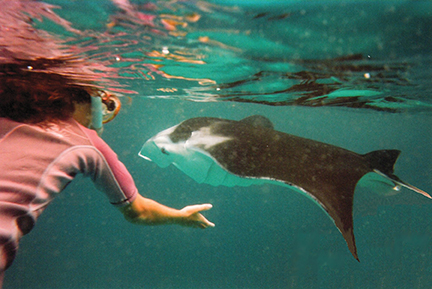
One of the most memorable experiences in the Marquesas was swimming with the manta rays of Hanamoenoa Bay on northwest Tahuata (2). Packs of six or more of these graceful, ebony-coated behemoths sweep through the bay on a regular basis, vacuuming up plankton with their huge mouths. Snorkeling alongside these gentle beauties is simply awe-inspiring. Although we were careful not to crowd the mantas, they showed no inhibitions, swimming right past and even brushing against us. It’s an incredible experience if you’re lucky enough to catch the mantas on one of their irregular sweeps through the bay; they seem to come and go on a two- to three-day schedule.
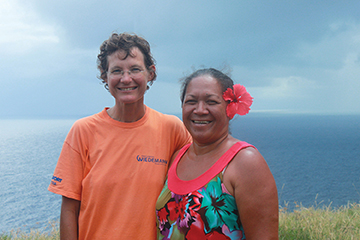
Throughout the Marquesas, local families frequently offer traditional meals at a price of $15 to $30 per person. Much more than a delicious meal, it’s also an opportunity to “taste” island life up close. You’ll be swept into the house, into the family, and into conversation on anything from politics and island economics to local gossip. Of course, it helps to speak a little French, but sign language works, too. It’s fun to witness the preparation that goes into the meal: instead of running to one of the tiny local shops, the family hunts and gathers in the immediate vicinity of their garden. Fruit is picked, chickens are cornered in the yard, fish hauled from the sea and a hunting expedition is dispatched to the hills for fresh goat meat. It’s a multicourse meal to remember.
GREAT READS
Three thousand miles of open ocean makes for a lot of reading hours. Each of the books mentioned below describes the Marquesas from the point of view of sailors of past generations. Topping the list is Thor Heyerdahl’s Fatu Hiva, in which the Norwegian explorer struggles to find equilibrium living with nature and natives in the 1940s. His poetic descriptions of the island as he found it 70 years ago show us what has changed, and what hasn’t.
Herman Melville’s Typee is a semi-autobiographical account of his time spent among cannibals on the eastern end of Nuku Hiva. It’s an entertaining read as much for its quaint reports of local scenes as for his detailed reporting on the Marquesan way of life. Melville wrote, “The varied dances of the Marquesan girls are beautiful in the extreme, but there is an abandoned voluptuousness in their character which I dare not describe.” Following in Melville’s wake is Jack London, who brilliantly captured his voyage from Hawaii to Nuku Hiva, and beyond, in the entertaining Cruise of the Snark. Hilarious passages discuss the mysteries of celestial navigation and lead in to beautiful descriptions of Nuku Hiva.
PRACTICALITIES
Marquesans are open and friendly people. Strike up a conversation and you will immediately be plied with more juicy “pamplemousse” (grapefruit) than you can possibly carry. French and Marquesan are the two languages of the Marquesas: start things off with a friendly “kaoha” (hello).
The two ports of entry to the islands are Atuona on Hiva Oa (8) and Taiohae on Nuku Hiva(9). Atuona is the less practical of the two, with a long walk to town from Tahauku Bay and no potable water. On the other hand, the surroundings are beautiful and it is the gateway to the windward end of the archipelago. The pros of Atuona are its medium-sized grocery stores, bakery and Internet connection right in the harbor. The cons are having to anchor fore and aft in very tight quarters in Tahauku Bay, also known as Traitor’s Bay. Woe is the hapless soul who anchors beyond the boundary formed by yellow crosses on either side of the bay. Some sailors find out the hard way with the 04:00 arrival of the local supply ship, the Aranui III, which summarily evicts anyone blocking their turning space off the dock.
Nuku Hiva’s port Taiohae (9), on the other hand, is a spacious bay with plenty of room for everyone. The only crowded area is near the dock where the Internet signal is strongest. Taiohae stores are the best stocked in the archipelago. Inexplicably, the twice-weekly produce market is often a dud. The village also has a small hardware store, a few mechanics, and offers an opportunity to fill propane bottles (with butane, that is). And while Hiva Oa was rationing diesel during our visit, there was plenty to be found in Taiohae. While in town, don’t miss the delicious sashimi at the open-air restaurant Viaki at the dock, where the fish is fresh and portions are large enough to satisfy even the hungriest sailor’s appetite.
Certain luxury goods make good gifts to exchange with friendly locals who offer bushels of fresh fruit from their groves. Wine is much appreciated, as are cosmetics and nail polish. Children admired our Crocs and wished for some for themselves. Basics like fishhooks are not in demand, but a good length of rope is worth its weight in gold—or juicy pamplemousse!
OFF THE BEATEN PATH?
The only disappointment, if that’s the word, of our Marquesas cruise were the crowds we found at each of the main anchorages. In the peak months of April, May and June, hundreds of boats pass through the archipelago. Our record lows were in Ua Pou (two boats) and Comptrolleur Bay (four), whereas Atuona was packed with 30 boats and Fatu Hiva’s Bay of Virgins hosted a full complement of 17. Of course, you can anchor in any number of less-frequented bays, but these are avoided for good reason: they can be uncomfortable or downright perilous, including the two slender bays of the least-visited island, Ua Huka. “We wanted to get off the beaten track,” lamented one sailor who ventured her own way. “Now we know why there is a beaten track!”
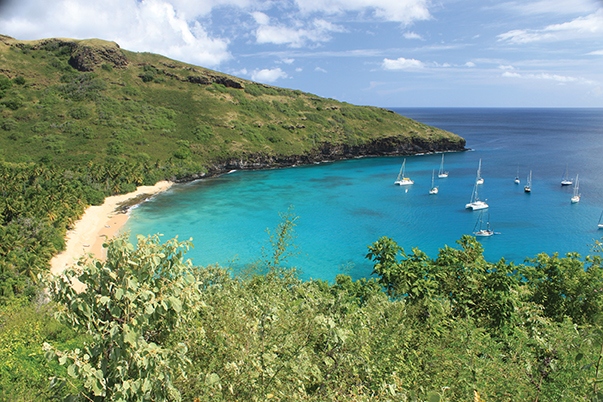
Throughout our Marquesas cruise, we found ourselves in awe of our surroundings again and again. We felt dwarfed yet entirely at peace with our small existence within this magnificent world. The wild, welcoming islands gave us a deep appreciation of how good life can be when days unfold slowly, with our family taking its pick from the many possibilities that each island offered. It was only the promise of more Polynesian islands beyond the horizon that drew us—ever so reluctantly—away.
Nadine Slavinski is the author of the book Lesson Plans Ahoy: Hands-On Learning for Sailing Children and Home Schooling Sailors. Currently on sabbatical from teaching, she cruises aboard her 35-foot sloop, Namani, with her husband and young son. After a season in the southwest Pacific, Namani is cruising eastern Australia. www.nslavinski.com and www.sailkidsed.net, list free resources for home schooling sailors.

















